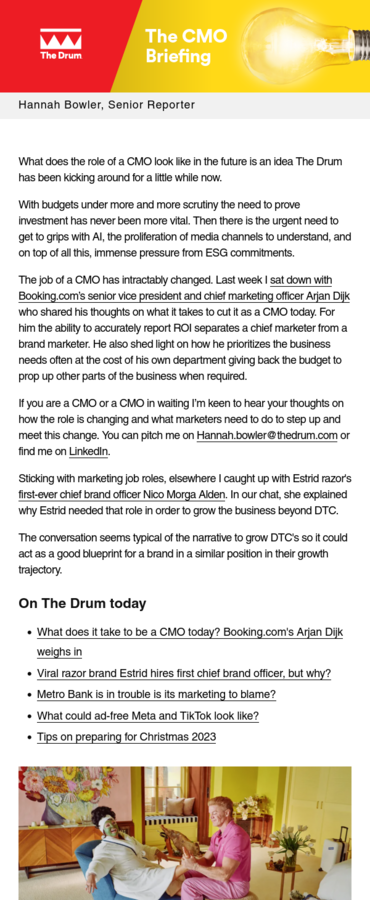What is content strategy and how do you develop a successful one?
For The Drum’s Content Marketing in Focus, Margo Waldrop breaks down how to build a successful content strategy, including why UX/UI is so important, key questions you should ask yourself determine the scope of your strategy, and how to understand your target audience.

Good content can be the difference between meeting and missing your revenue target - but an effective strategy is crucial / Jason Goodman/Unsplash
I have zero sense of direction, so when I travel, I rely heavily on my Google Maps app. Before I take a road trip, I mark the points where I need to go, where I will stop for breaks, and how long it will take to get to my destination.
A content strategy is the same premise. Content is created to guide users on where they need to go, the stops they need to make along the way, and the destination they should arrive at. Which normally is a product purchase, sign-up, or other call-to-action (CTA) you have designed for them. It is the road map your audience will follow so they don’t get lost and fall in love with another brand along the way.
What is content strategy and digital content strategy?
Before we dive into content strategy, let’s define ‘content’. Content is a compilation of information produced for a particular audience. However, it actually goes much deeper than that. It is how, where, why, and what you communicate to your audience. For companies, it is the visual and auditory interpretation of your brand and products, and it serves several purposes. Content should:
- inform
- connect
- build trust
- guide
- prompt action
While that may seem like a tall order, its rather simple if strategically created with an end goal in mind.
Defining ‘content strategy’ involves a little more thought. Kent State University has a brilliant but complicated definition: “It’s a well thought-out plan and approach to the deliverables (written, visual, video, etc.) of a specific space, with the goal of increasing user interaction and directing it to meet specific company objectives.” In simpler terms, it is how you use your content assets to communicate with your target audience.
Advertisement
Another definition you should know is ‘digital content strategy’, which is the strategy you create for your digital assets: it can include, videos, websites, downloadable items, marketing emails, blogs, or auditory content. Digital content sits within your content bucket and must be included in your comprehensive marketing strategy to cover all your bases.
Content strategy and the UX/UI experience
Content strategy and user experience (UX) / user interface (UI) work hand in hand, facilitating the consumer’s experience to achieve content goals. It’s the united pairing of two parts working together: peanut butter and jelly, Batman and Robin, burgers and fries, or Lennon and McCartney. It’s hard to imagine one without the other.
UX is the entire experience of interacting with a brand, while UI comprises the manual touchpoints within the user journey. Examples of UI elements include, icons, screens, toggles, buttons, text fields, dropdown lists, sliders, search fields, pagination, tooltips, notifications, tags, icons, and other items that are navigated during an interaction.
The fundamental aspects of UX and UI make it clear why they are so important for your content.
The essentials of UX include:
- Interactive design
- Visual design
- Information architecture
While the essentials of UI are:
- Structure
- Simplicity
- Visibility
- Feedback
- Tolerance
- Reuse
Incorporating UX/UI into your content strategy is instrumental in not only creating an easy journey for users (ending at the destination you choose for them, no less), but also to help them cross content channels. The more touchpoints you have to interact with consumers, the more trust you can build.
If a user’s path is a complicated one, no matter how fantastic your brand is, they will jump ship at some point. Make sure to keep the user experience top of mind when creating your strategy, and create content that is easy to use, and appears to the right people, in the right places, at the right time.
Using omnichannel marketing in your strategy
Omnichannel content is the unicorn of marketing and its use in your content plan is essential. Despite its name, omnichannel marketing is simply creating content that can be used seamlessly across different integrated channels, such as social media, platforms, websites and devices.
Advertisement
Its sister strategy, multi-channel is most often used, but lacks a seamless, communicative, user-centric experience. Omnichannel is a step above, and it is this unification of content that makes it a better bet. Think of it this way: what if you had to use a different phone for different people? One phone to call Dad and another phone to call Mom. That is essentially the difference between multi-channel and omnichannel marketing. A seamless integration that makes the experience smoother and more satisfying to the user.
Scoping questions for your content strategy
Your content strategy is only as good as the answers you’ve gained from asking the right questions. They help determine the scope of your plan and construct the framework from which your strategy will grow:
- Strategize your company’s short term/long term goals - Brand awareness? Sales? Growth? Improved rankings? Increase sales of a specific product?
- Clarify your message – Who are you as a brand? What you want to say? Why you need to say it?
- Determine the type of content needed for each funnel stage – Informational? Instructional?
- Content distribution – How will you distribute your content? Owned media, earned media or paid media?
- Don’t forget SEO – How are your current rankings for important content? Can it improve? Do you have older content that can be updated? How does your content compare to that of competitors?
Also, evaluate the channels and content formats that work best for your consumers and your company. Are there underperforming channels you may need to rework or put on the back burner? Where does your target audience hang out? Are you using their language?
It’s important to remember that data is your friend and will support many of the answers you need. Don’t give up. Homework like this will help you create a solid strategy.
Get to know your target audience
Your target market is the specific group of people you want to reach with your content, and thoroughly understanding them is the bed rock for a stable content strategy. If you acquire this coveted knowledge, you will build a powerful house of content. Here are a few questions to get you started:
- Why would they be interested in your product in the first place?
- Why should they spend time getting to know your brand?
- What are their ‘pain points’ and how can you help them?
- What are their demographics (age, job, location, salary, interests)?
- What are their psychographics (lifestyle preferences, beliefs, behaviors, attitudes)?
- Where do they hang out online (TikTok, Facebook, websites, Instagram, Twitter, blogs, LinkedIn)?
- How do they like to communicate (texts, emails, video, apps, audio)?
- What stage of the buying journey will they be in?
- How do they need to think and feel to connect with your brand?
As varied as these questions are, they boil down to one thing: understanding the deepest needs of your customer. Try on these scenarios for size:
- Jackie doesn’t need another running shoe, but she does need a running shoe that doesn’t cause blisters or weigh her legs down, especially when she sweats.
- Grace doesn’t need another lipstick, but she does need one that moisturizes because she works in the heat and dry air all day.
- Paul doesn’t need another CMS tool, but he does need one that is simple and fast, so he doesn’t have to keep staying late after work with a newborn baby at home.
These stories demonstrate the power of understanding why a person undergoes a buying journey. That ‘why’ is critical. Taking the time to dive deep into your customers’ psyche will help shape your strategy into one that completely serves your audience and ultimately pays off for everyone.
Suggested newsletters for you
Part of this deep dive is also understanding that your customers’ needs will change throughout their buying journey. Be sure to meet your audience where they are in the buying journey and create content that is designed for the different stages they will traverse. For example, a landing page can be used at several places in the journey, but the content will need to change. Verbiage for a free guide sign-up will need to speak differently than a landing page that has a ‘buy’ button. Structure this correctly and your buyers will float effortlessly through your designated touchpoints.
Perform a content audit
Creating a content strategy will reap the highest benefit if you take stock of your current content. Take inventory and decide what is working and what isn’t. Run some much-needed analytics, re-think the value of low performing material, and note what is winning the game.
Your website is the first place to start in your audit. Every page needs to have a purpose and guide the user to where you need them to go. UX/UI is an important part of this. The user must have an easy path, through each page, where their eyes travel to designated spots. A heatmap tool is the key to gather this type of information. Heatmap tools analyze user behavior throughout the page by highlighting the areas where users spend the most and least time. So, if your CTA is getting little attention, it needs improvement or a different placement. Crazy Egg, Hotjar, and Smartlook have some of the top heatmap tools available.
And don’t forget to take a hard look at your processes. If everything runs like clockwork, you can always make improvements that will contribute to your content strategy. Data measurements, tracking results, content calendars, and efficient workflows all have important places in your content plan.
Creating a content strategy doesn’t have to be a head-scratching experience if you know your company well and keep track of data. Taking your marketing road-trip is easily doable. Plot out the destination and the stops along the way and the rewards will be great.
Visit our Content Marketing in Focus hub for more news, insights and strategies around content marketing.

